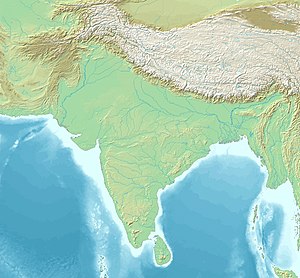| Siege of Chittor | |||||||
|---|---|---|---|---|---|---|---|
| Part of List of battles of Rajasthan | |||||||
| |||||||
| Belligerents | |||||||
|
| Malwa Sultanate | ||||||
| Commanders and leaders | |||||||
|
|
Ghiyath Shah Zahir-ul-Mulk † | ||||||
 | |||||||
The Siege of Chittor was laid by Malwa Sultanate in 1473. Kingdom of Mewar under Rana Raimal repulsed the besiegers and sultan of Malwa was forced to retreat.
Siege
Sultan Ghiyath Shah succeeded his father Mahmud Khalji and he undertook several expeditions against Mewad. The sultan of Malwa laid siege of Chittor and devastated Dungarpur, Rata and Kalla two resilient warriors were killed in the defense. The Rajputs, led by Rana Raimal, resisted and successfully defended against multiple attacks. A Rajput of Gaur community displayed great determination and killed many soldiers of sultan of Malwa. Zahir, along with many other officers were killed and sultan was forced to retreat.
Aftermath
See also: Battle of MandalgarhThe Sultan of Malwa again sent his commander Zafar Khan to plunder the eastern part of the Mewar but he was defeated in the Battle of Mandalgarh and the Sultan offered peace which was accepted by Rana Raimal. The King of Mewar further inscripted about his victory over the Sultan of Malwa, as translated in English—
King Raja Mai deprived Ghiyasa (Ghiyasuddin), the lord of the Shakas (Mussalmans) of his pride on (near) the Chitrukuta, who fought with instruments of capturing, gave blows with ploughs, bewildered (the enemies) with his elephants, had numerous and active troops of horses and camels, had many heroes who fought with loud war-cry and who fought with terrible blows.
On the death of his Gaur commander, Rana Raimal put up his statue on a peak of Chittor, which is named after him, on which it is further inscribed—
In that battle, a great hero called Gaura constantly destroyed the army of the Shakas, therefore a peak of Chitrakuta, being a portion of the fort, bears this name (Gaura).
See Also
References
- ^ Somani, Ram Vallabh (1976). History of Mewar: from earliest times to 1751 A.D. C.L. Ranka, Jaipur. p. 48. OCLC 2929852.
- ^ Sarda, Har Bilas (1918). Maharana Sanga; the Hindupat, the last great leader of the Rajput race. Ajmer, Scottish Mission Industries. p. 6. OCLC 548007.
- Mankekar, D. R. (1976). Mewar Saga: The Sisodias' Role in Indian History. Vikas Publishing House. ISBN 978-0-7069-0416-1.
- ^ Medieval Malwa A Political And Cultural History 1401-1562. Munshi Ram Manohar Lal. p. 223-225.
- Munshi, K. M. (1960). History and Culture Of The Indian People Vol.6 Delhi Sultanate. Bharatiya Vidya Bhavan. p. 338-339.